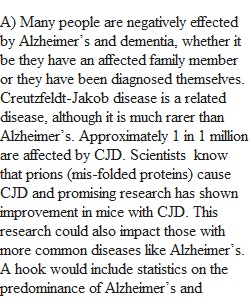


Q ) No matter which project you are completing for the DYOP assignment, your summary will need an introduction that will motivate your audience to want to know more and a conclusion that will motivate them to take action or think about something more deeply. The following questions will help you think about how to begin and end your essay. A) What specific information might be good to use as a hook for your summary? Maybe something you have found during your research. B) Who is your main target audience? Why is this topic important for them specifically? Who are you excluding (for example, people without reliable internet access would not really be able to utilize a company website very easily)? C) What person or groups of people might disagree with your arguments, hypotheses, or products? What might they say? D) What should the audience do with the information you are giving them? What's the call-to-action? E) Think back again to the ideas that you had for a hook in your introduction. How can you tie this in with your conclusion and your thesis? Your conclusion should leave the reader with something to think about or something to do in addition to recapping your purpose. 2) Construct a brief proposal for your DYOP assignment based on the following outline. See Chapter 12 of everything's an argument for more information about proposals. A) Introduction -Declare a project type. -State your reasoning for that choice. B) Summarize your project ideas. C) State your purpose. Examples: -Hypothetical Experiment; the experiment...should be approved because... -PowerPoint/Prezi; agree with my way of thinking...about...because... -Homepage; my product or service...is the best because... D) Describe your methods for completing the project successfully. -Describe your process or plan, step-by-step -List needed materials and resources, demonstrate feasibility -List types of potential evidence and references E) Describe the rhetorical situation of your project. -You are trying to get someone to do something. Who, what, and why? -Define your audience, claim, reasoning, purpose, and warrants (what can we assume is important to our audience?). -Context for this project = your future career, field of study. F) Define the significance of your research. 3)Even though you don't actually have to deliver your presentation for this class, it is still important to practice good public speaking skills. ***I would like to offer extra credit to anyone who would be willing to post a recording of themselves delivering their presentation.*** You can record yourself using your cell phone and upload the video to the Extra Credit submission link on our Canvas homepage. A) Have you ever had to give a presentation in front of a room full of people? When? How did you feel during that experience? B) If you have given presentations, do you have any tricks to calm your nerves? If so, what? C) How do you typically prepare for public speaking situations? Do you make index cards? rehearse? create visuals? improvise on the spot? D) How can you tell the difference between a good public speaker and an ineffective one?
View Related Questions